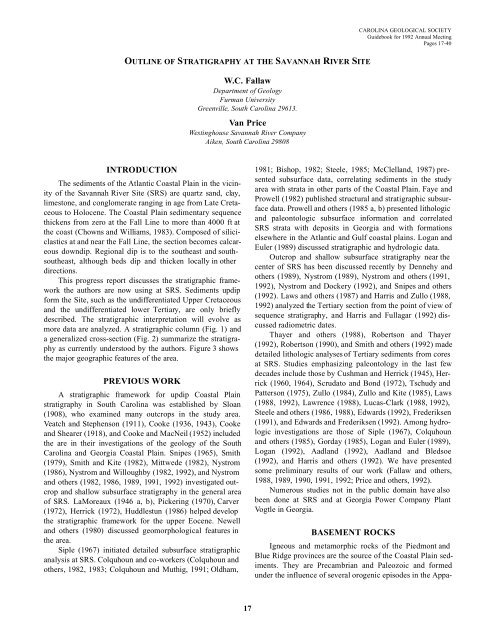Download Guidebook as .pdf (1.8 Mb) - Carolina Geological Society
Download Guidebook as .pdf (1.8 Mb) - Carolina Geological Society
Download Guidebook as .pdf (1.8 Mb) - Carolina Geological Society
Create successful ePaper yourself
Turn your PDF publications into a flip-book with our unique Google optimized e-Paper software.
CAROLINA GEOLOGICAL SOCIETY<br />
<strong>Guidebook</strong> for 1992 Annual Meeting<br />
Pages 17-40<br />
OUTLINE OF STRATIGRAPHY AT THE SAVANNAH RIVER SITE<br />
W.C. Fallaw<br />
Department of Geology<br />
Furman University<br />
Greenville, South <strong>Carolina</strong> 29613.<br />
Van Price<br />
Westinghouse Savannah River Company<br />
Aiken, South <strong>Carolina</strong> 29808<br />
INTRODUCTION<br />
The sediments of the Atlantic Co<strong>as</strong>tal Plain in the vicinity<br />
of the Savannah River Site (SRS) are quartz sand, clay,<br />
limestone, and conglomerate ranging in age from Late Cretaceous<br />
to Holocene. The Co<strong>as</strong>tal Plain sedimentary sequence<br />
thickens from zero at the Fall Line to more than 4000 ft at<br />
the co<strong>as</strong>t (Chowns and Williams, 1983). Composed of silicicl<strong>as</strong>tics<br />
at and near the Fall Line, the section becomes calcareous<br />
downdip. Regional dip is to the southe<strong>as</strong>t and southsouthe<strong>as</strong>t,<br />
although beds dip and thicken locally in other<br />
directions.<br />
This progress report discusses the stratigraphic framework<br />
the authors are now using at SRS. Sediments updip<br />
form the Site, such <strong>as</strong> the undifferentiated Upper Cretaceous<br />
and the undifferentiated lower Tertiary, are only briefly<br />
described. The stratigraphic interpretation will evolve <strong>as</strong><br />
more data are analyzed. A stratigraphic column (Fig. 1) and<br />
a generalized cross-section (Fig. 2) summarize the stratigraphy<br />
<strong>as</strong> currently understood by the authors. Figure 3 shows<br />
the major geographic features of the area.<br />
PREVIOUS WORK<br />
A stratigraphic framework for updip Co<strong>as</strong>tal Plain<br />
stratigraphy in South <strong>Carolina</strong> w<strong>as</strong> established by Sloan<br />
(1908), who examined many outcrops in the study area.<br />
Veatch and Stephenson (1911), Cooke (1936, 1943), Cooke<br />
and Shearer (1918), and Cooke and MacNeil (1952) included<br />
the are in their investigations of the geology of the South<br />
<strong>Carolina</strong> and Georgia Co<strong>as</strong>tal Plain. Snipes (1965), Smith<br />
(1979), Smith and Kite (1982), Mittwede (1982), Nystrom<br />
(1986), Nystrom and Willoughby (1982, 1992), and Nystrom<br />
and others (1982, 1986, 1989, 1991, 1992) investigated outcrop<br />
and shallow subsurface stratigraphy in the general area<br />
of SRS. LaMoreaux (1946 a, b), Pickering (1970), Carver<br />
(1972), Herrick (1972), Huddlestun (1986) helped develop<br />
the stratigraphic framework for the upper Eocene. Newell<br />
and others (1980) discussed geomorphological features in<br />
the area.<br />
Siple (1967) initiated detailed subsurface stratigraphic<br />
analysis at SRS. Colquhoun and co-workers (Colquhoun and<br />
others, 1982, 1983; Colquhoun and Muthig, 1991; Oldham,<br />
1981; Bishop, 1982; Steele, 1985; McClelland, 1987) presented<br />
subsurface data, correlating sediments in the study<br />
area with strata in other parts of the Co<strong>as</strong>tal Plain. Faye and<br />
Prowell (1982) published structural and stratigraphic subsurface<br />
data. Prowell and others (1985 a, b) presented lithologic<br />
and paleontologic subsurface information and correlated<br />
SRS strata with deposits in Georgia and with formations<br />
elsewhere in the Atlantic and Gulf co<strong>as</strong>tal plains. Logan and<br />
Euler (1989) discussed stratigraphic and hydrologic data.<br />
Outcrop and shallow subsurface stratigraphy near the<br />
center of SRS h<strong>as</strong> been discussed recently by Dennehy and<br />
others (1989), Nystrom (1989), Nystrom and others (1991,<br />
1992), Nystrom and Dockery (1992), and Snipes and others<br />
(1992). Laws and others (1987) and Harris and Zullo (1988,<br />
1992) analyzed the Tertiary section from the point of view of<br />
sequence stratigraphy, and Harris and Fullagar (1992) discussed<br />
radiometric dates.<br />
Thayer and others (1988), Robertson and Thayer<br />
(1992), Robertson (1990), and Smith and others (1992) made<br />
detailed lithologic analyses of Tertiary sediments from cores<br />
at SRS. Studies emph<strong>as</strong>izing paleontology in the l<strong>as</strong>t few<br />
decades include those by Cushman and Herrick (1945), Herrick<br />
(1960, 1964), Scrudato and Bond (1972), Tschudy and<br />
Patterson (1975), Zullo (1984), Zullo and Kite (1985), Laws<br />
(1988, 1992), Lawrence (1988), Luc<strong>as</strong>-Clark (1988, 1992),<br />
Steele and others (1986, 1988), Edwards (1992), Frederiksen<br />
(1991), and Edwards and Frederiksen (1992). Among hydrologic<br />
investigations are those of Siple (1967), Colquhoun<br />
and others (1985), Gorday (1985), Logan and Euler (1989),<br />
Logan (1992), Aadland (1992), Aadland and Bledsoe<br />
(1992), and Harris and others (1992). We have presented<br />
some preliminary results of our work (Fallaw and others,<br />
1988, 1989, 1990, 1991, 1992; Price and others, 1992).<br />
Numerous studies not in the public domain have also<br />
been done at SRS and at Georgia Power Company Plant<br />
Vogtle in Georgia.<br />
BASEMENT ROCKS<br />
Igneous and metamorphic rocks of the Piedmont and<br />
Blue Ridge provinces are the source of the Co<strong>as</strong>tal Plain sediments.<br />
They are Precambrian and Paleozoic and formed<br />
under the influence of several orogenic episodes in the Appa-<br />
17













